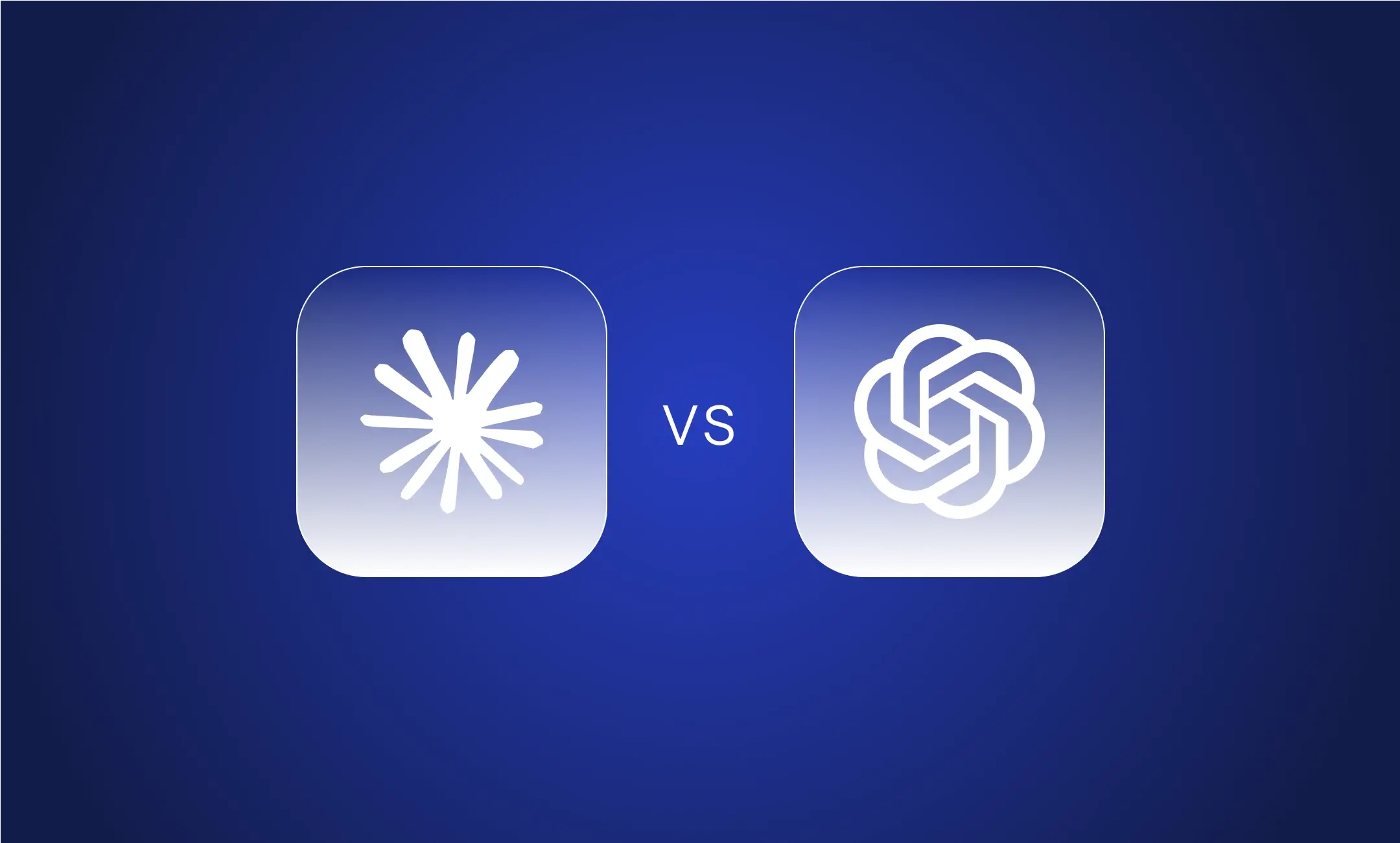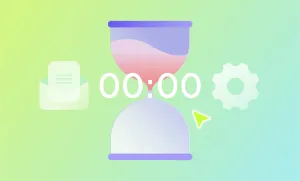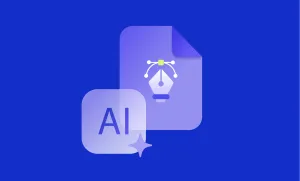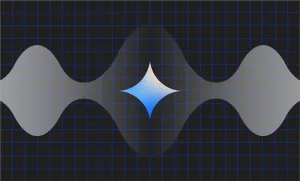ChatGPT and Claude are two of the biggest names in generative AI right now, and if you’re a creator, you’ve probably wondered which one actually works better for you.
We put them head-to-head across real creative workflows: brainstorming ideas, writing scripts, summarizing documents, and crafting content for different platforms. The results? Sometimes close. Sometimes wildly different.
This guide breaks down exactly how each AI performs in practice, what they’re good at, where they fall short, and what kind of work they’re best suited for. If you’re trying to decide which one deserves a place in your creative process, here’s everything you need to know.
Key Findings
- ChatGPT is fast, structured, and platform-aware. Claude is slower, but more human and emotionally resonant.
- ChatGPT adapts tone with precision across platforms. Claude feels more conversational and intuitive, but less stylistically flexible.
- Claude shines in long-form storytelling and narrative cohesion. ChatGPT leads when it comes to clarity, segmentation, and production-friendly scripting.
- ChatGPT wins on speed, visual capabilities, and multimodal workflows. Claude trades that for restraint, insight, and long-context memory.
- Claude is more cautious and accurate by default. ChatGPT is bolder, occasionally inventing for style, but usually faster to deliver.
Table of Contents
What is ChatGPT?
ChatGPT is a generative AI chatbot developed by OpenAI, a San Francisco-based research company founded in 2015 by a team that included Sam Altman, Greg Brockman, Ilya Sutskever, Wojciech Zaremba, and Elon Musk. It’s designed to generate human-like text, answering questions, drafting ideas, writing code, and helping with everything from storytelling to scripting.
When did ChatGPT come out?
The public release came on November 30, 2022, and within weeks, ChatGPT was everywhere, becoming the fastest-growing consumer application in history, with 100 million users in just two months. Its rise wasn't accidental. Behind the scenes, it runs on a massive Microsoft Azure supercomputing infrastructure, powered by Nvidia GPUs, a system that reportedly cost hundreds of millions to build.
Is ChatGPT free?
Originally offered as a free research preview, ChatGPT now runs on a freemium model. Free-tier users get access to GPT-4o, the latest multimodal model, but with rate limits. Subscriptions like ChatGPT Plus, Team, and Enterprise offer faster responses, priority access, and expanded features for those who need more power and flexibility.
How many people use ChatGPT?
Today, it supports a global community of creators, developers, students, and professionals. With over 122 million daily users and more than 400 million weekly active users, ChatGPT has become a go-to tool not just for productivity, but for ideation, storytelling, and creative collaboration.
What is Claude AI?
Claude is a generative AI chatbot developed by Anthropic, an AI safety and research company founded in 2021 by former OpenAI researchers, including siblings Dario and Daniela Amodei. Named after Claude Shannon, ‘the father of information theory’, an American mathematician and computer scientist, Claude is designed to be aligned with human intent, especially when the conversation involves layered storytelling, critical thinking, or nuanced interactions.
How does Claude AI work?
Anthropic describes its mission as building AI systems that are “helpful, honest, and harmless”, the HHH framework. That philosophy is embedded deeply into Claude’s design. Its training approach, called Constitutional AI, prioritises ethical reasoning and self-correction, with the goal of producing responses that are not only useful but safe, measured, and context-aware.
When did Claude come out?
The Claude model series has evolved rapidly since its debut. Claude 1 was released in March 2023, followed by Claude 2 in July 2023, Claude 3 in March 2024, and Claude 4 in May 2025. Each major release has introduced improvements in reasoning, context length, and usability; with Claude 3 and 4 models offering significantly expanded capabilities for handling massive documents, long-form creative work, and deep research tasks.
How can you use Claude?
Claude is available via the Claude AI website, the Claude mobile app and through an API for developers. The free version of Claude offers access to Claude Sonnet 4, while paid tiers unlock more usage, priority access, and full capabilities.
Claude has also quickly gained popularity among creators, researchers, and businesses, boasting 18.9 million monthly active users worldwide, with the US and India being the two major markets for the chatbot.
ChatGPT and Claude: Model Breakdown
With so many versions, names, and features floating around, it’s easy to lose track of which AI model does what and which one fits your workflow best.
This breakdown gives you a clear, side-by-side look at the current models (June 2025) powering ChatGPT and Claude: what they’re built for, how you can access them, and which ones are best suited for everything from quick brainstorming to deep, structured thinking.
ChatGPT Models
ChatGPT isn’t powered by a single brain, it’s a whole lineup of models tuned for different kinds of thinking. The most used today are GPT-4o, the default for free and Plus users, known for handling everyday tasks and multimodal input, and GPT-4.1, favoured by developers for its strength in coding and logic.
Behind the scenes, OpenAI also runs specialized models for research, reasoning, and STEM. The more advanced your access tier, the more of these minds you can tap; each one offering a different kind of rhythm for getting things done.
Claude AI Models
Claude’s model family is created with a quiet kind of precision, each version tuned for a different depth of thought. Sonnet 4 is the everyday go-to: balanced, fast, and free to use for most creators. At the top end, Opus 4 handles deep reasoning and complex coding with calm confidence. The system is layered and built to meet you where your ideas start.
And of course, this is just a snapshot: both ecosystems are evolving rapidly, and a month from now, there might be new models, new names, and new capabilities reshaping the landscape all over again.
ChatGPT and Claude Pricing
Let’s take a look at the pricing options offered by both companies.
ChatGPT Pricing
OpenAI offers a range of ChatGPT plans tailored to different user needs, from free access with essential features to advanced tiers for professionals, teams, and enterprises seeking enhanced capabilities and support.
- Free (no cost): Entry-level access with essential AI tools, including web browsing, file uploads, voice and image capabilities, and basic coding assistance, with limited daily usage.
- Plus ($20/month): Adds faster, more capable AI models, increased limits, enhanced voice/video tools, full file handling, and access to broader web-based features.
- Pro ($200/month): Unlocks everything from Plus, with full access to all models, higher research limits, video creation tools, and early access to experimental features and AI agents.
- Team ($25/user/month, billed annually): Designed for groups, this tier includes Pro-level tools along with shared workspaces, admin features, and collaboration-friendly controls.
- Enterprise (custom pricing): Offers maximum flexibility and support, including all Team features plus advanced security, custom deployments, premium support, and tailored AI solutions.
Claude AI Pricing
Anthropic doesn’t fall behind either. The company provides Claude subscription options designed to accommodate everyone from casual users to power users and organizations, with plans focused on usage capacity, collaboration, and enterprise-grade security.
- Free: Ideal for light users who want full feature access with some daily limits.
- Pro ($20/mo): Best for creators and professionals who need more usage, project organization, code support, and smarter research tools.
- Max (from $100): Made for power users who rely on Claude throughout the day, this plan boosts your capacity and gives priority during peak times.
- Team ($25/mo/user): Great for small teams and collaborations, offering shared tools and billing.
- Enterprise (custom pricing): Built for organizations that need top-tier security, admin controls, massive context handling, and deep cloud integration.
Both OpenAI and Anthropic also offer API access to their respective models, enabling developers and businesses to integrate powerful AI capabilities directly into their own applications and workflows.
ChatGPT vs Claude: Which AI Excels at What?
ChatGPT and Claude have quickly become household names, each carving out its own reputation for brilliance and versatility. But beyond the buzz, how do these two giants really compare when it comes to handling real-world tasks?
This exploration dives into the unique strengths and quirks of both ChatGPT and Claude, peeling back the layers to reveal which AI thrives in creative brainstorming, which one dominates in research depth, and how they differ in tone and adaptability.
By understanding these points, you’ll get a clearer picture of how to tap into the full potential of these powerful tools, and maybe even find a surprising favourite along the way.
1. Brainstorming
We invited both ChatGPT and Claude to generate 10 unique podcast ideas, putting their creativity, clarity, and versatility across different genres to the test.
ChatGPT offered a broader range of formats and genres, from interactive game-style shows to tightly structured educational series. Its ideas like “Science on the Street” and “Pitch Perfect” suggested a polished, production-ready approach, while shorter formats like “Snackable History” and “Mindful Minutes” showed an awareness of modern listening habits.
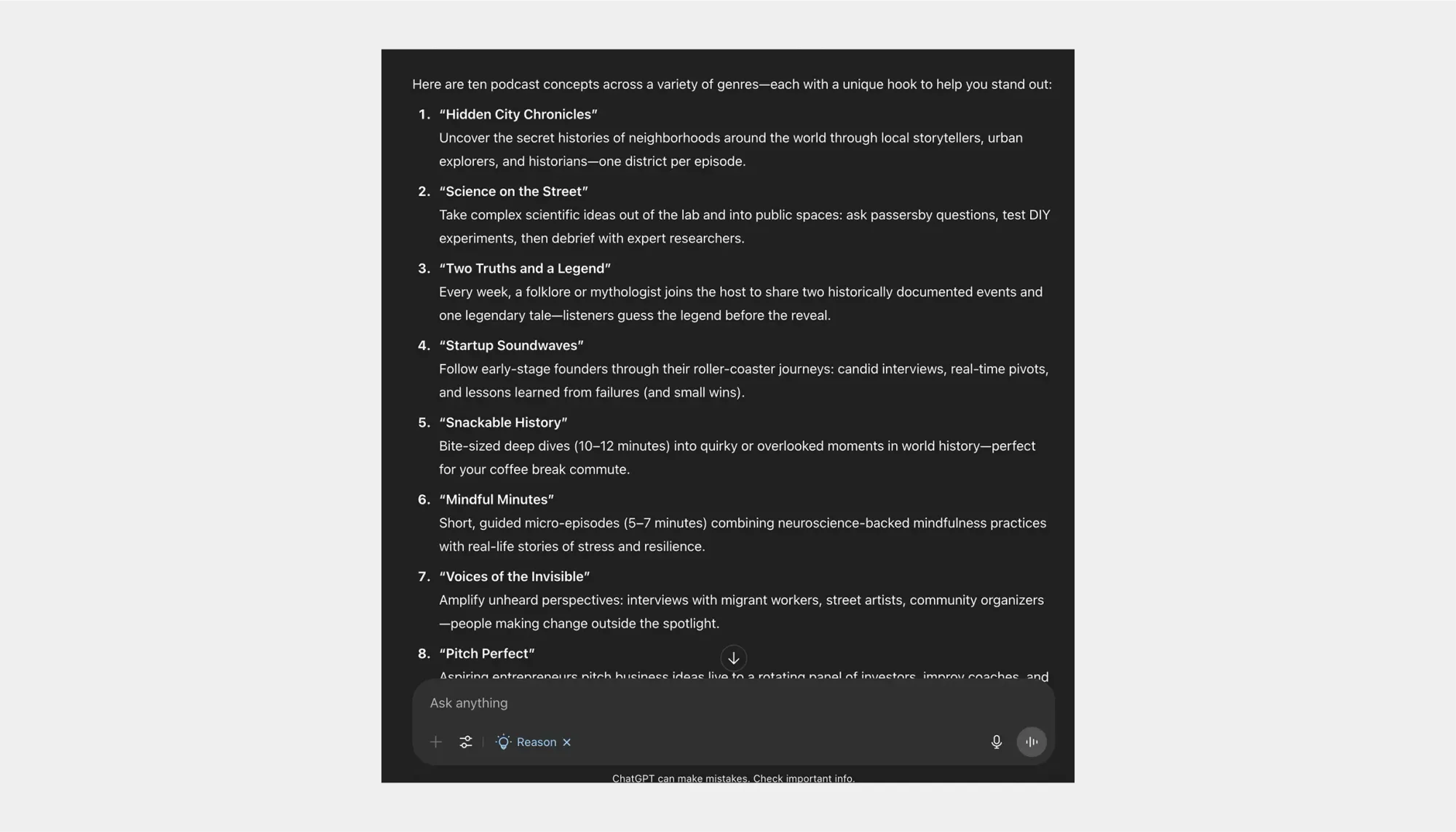
Claude, by contrast, leaned heavily into narrative depth and human-centered storytelling. Its ideas often revolved around emotional turning points, unusual inheritances, or forgotten cultural threads, concepts like “The Last Day” and “Inherited” painted vivid, character-driven episodes. Even when it tackled more conceptual angles, such as “Failed Predictions” or “The Other Version,” it maintained a strong emphasis on personal perspective and narrative texture.
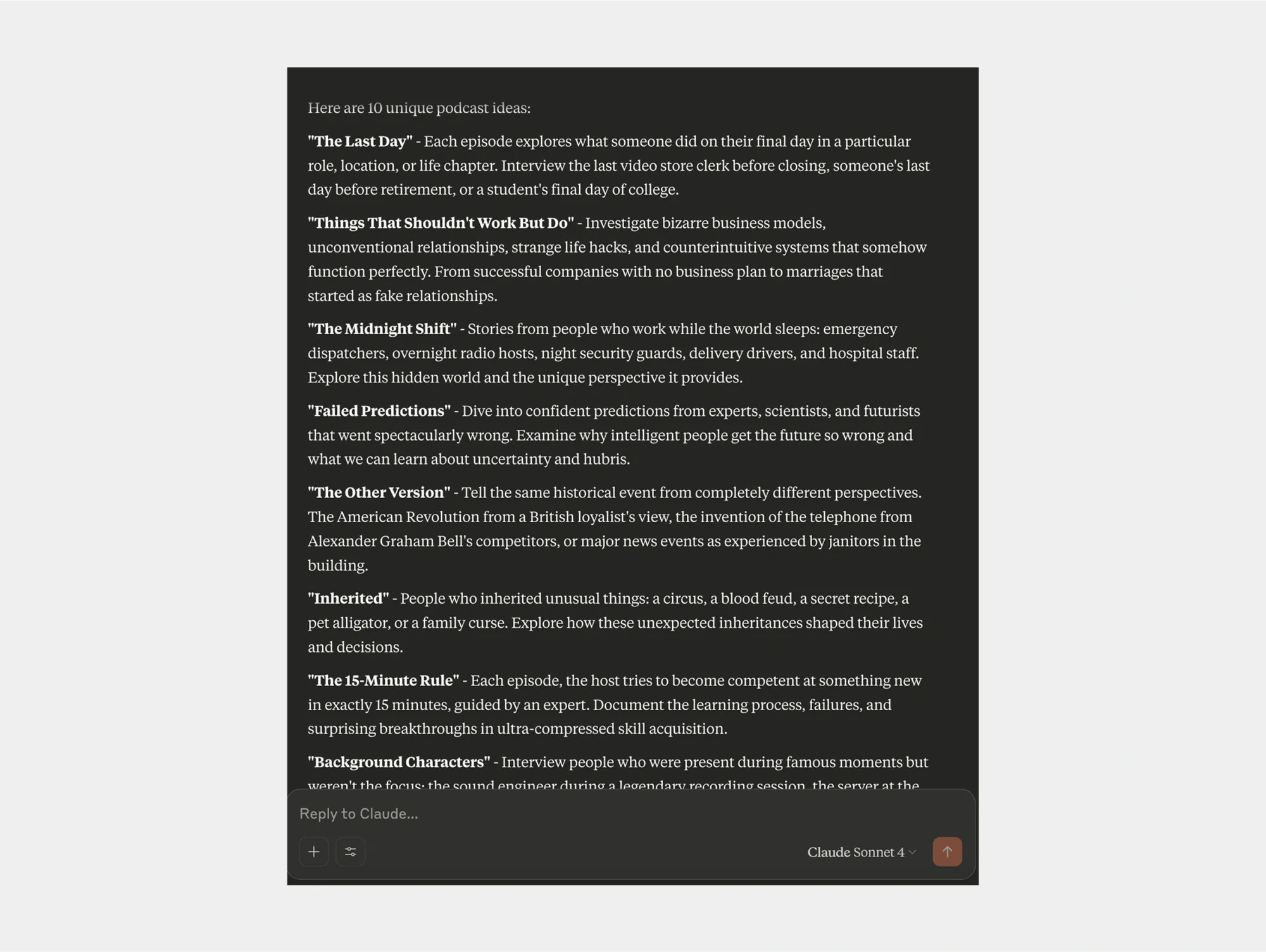
Who wins?
Both models showcased distinct creative identities: Claude favoured emotional storytelling and introspection, while ChatGPT leaned into flexibility, pacing, and concept clarity. Depending on the type of podcast you're building, either model could have offered the inspiration you needed.
2. Podcast Script Writing
We gave both ChatGPT and Claude AI a creative challenge: write a podcast script for Voices of the Invisible, a show centered on stories that rarely make the headlines: those of migrant workers, street performers, community activists, and others working behind the scenes of everyday life. The goal wasn’t just to tell a story, but to build one that felt grounded, emotionally resonant, and well-structured for a host-led interview format.
Could each model bring empathy to the forefront while still delivering a script ready for the mic?
ChatGPT’s script embraced a multi-segment format, weaving together three distinct interviews that showcased a diverse range of unheard voices, from a migrant worker to a street artist and a community organizer. This approach offered breadth, allowing listeners to experience different facets of invisibility within a single episode.
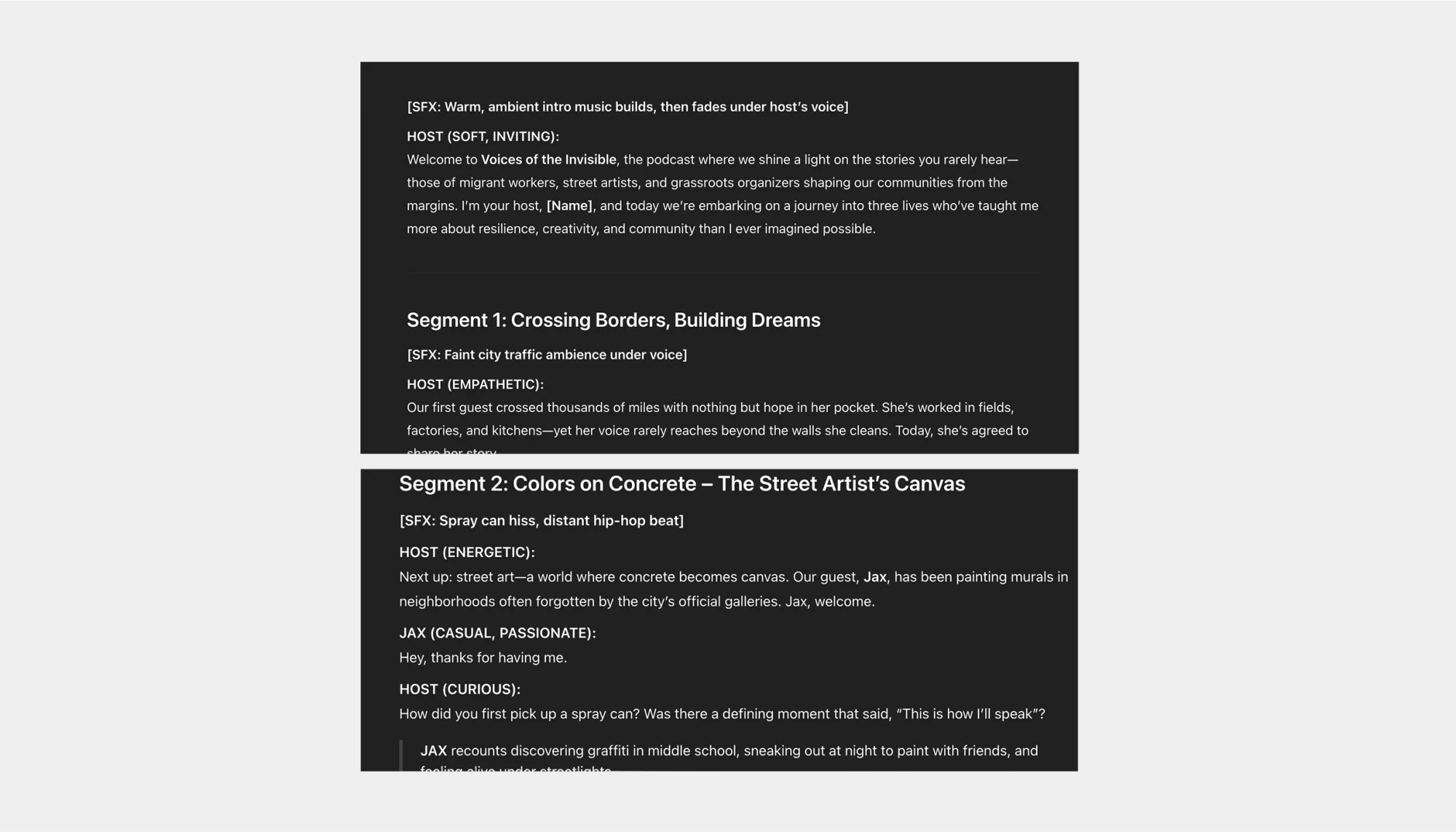
The host’s role was clear and guiding, gently steering conversations and providing smooth transitions that kept the narrative moving forward. The tone balanced empathy with journalistic precision, creating an engaging, accessible listening experience. ChatGPT also demonstrated a strong sense of production, thoughtfully incorporating sound effects and musical cues that enhanced pacing and atmosphere, making the episode feel polished and ready for broadcast.
Claude’s script took a different route by focusing deeply on one individual’s story, unfolding with a rich, intimate portrait of Maria Santos, a hospital custodian. The narrative moved at a slower, more reflective pace, allowing for emotional depth and sensory detail that would immerse listeners in Maria’s world.
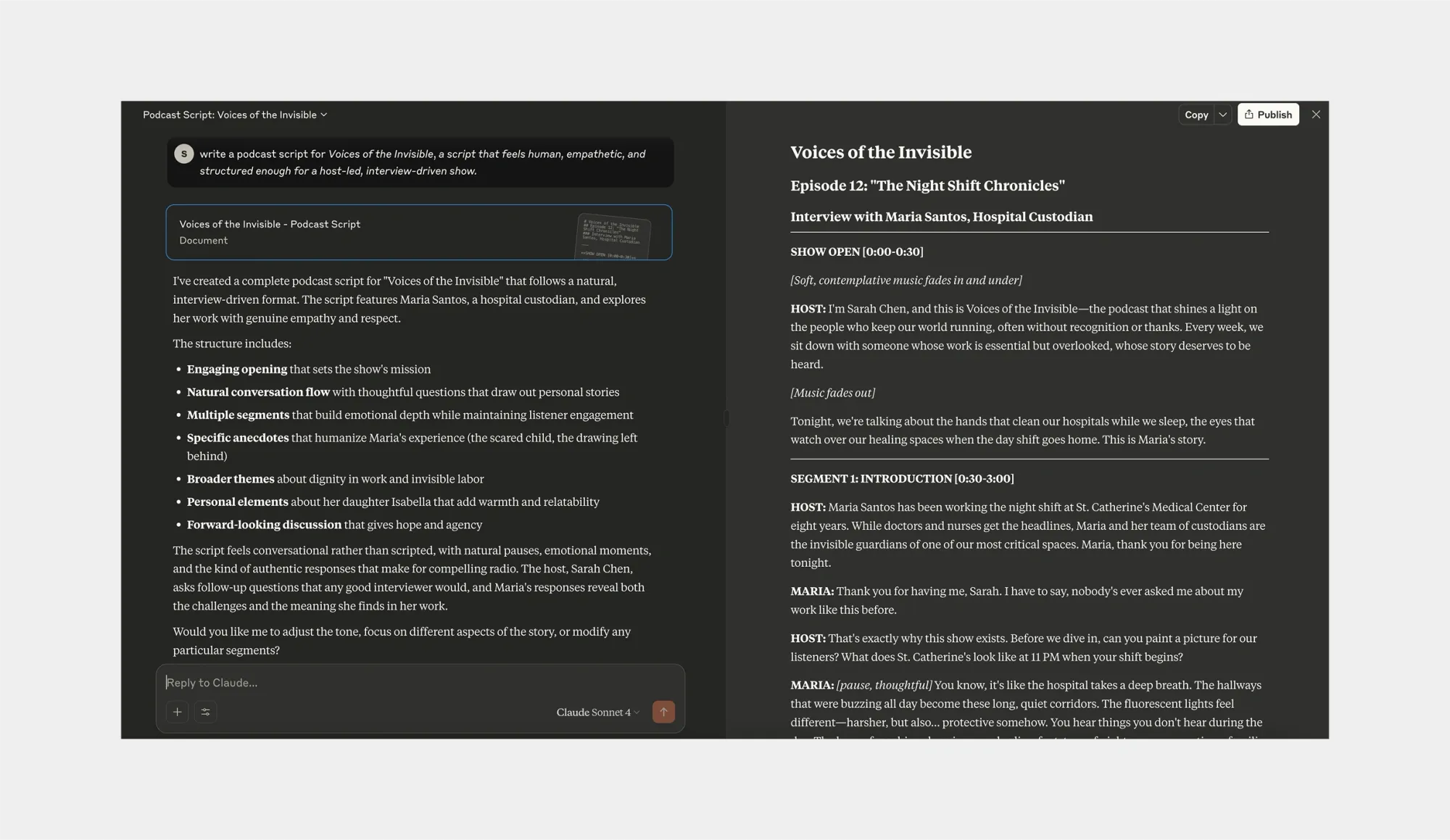
The host acted more as a compassionate listener, providing space for Maria’s voice to resonate fully without interruption or over-direction. This created a documentary-style feel that emphasized authenticity and emotional realism. While Claude’s production notes were lighter on technical elements, the natural rhythm of the conversation and vivid storytelling created a powerful connection that would draw the audience into the heart of invisible labour and dignity.
Who wins?
Depending on the podcast’s style and goals, either script could serve as an excellent foundation; ChatGPT for polished diversity and momentum, Claude for intimate storytelling and lasting impact.
However, regardless of the format, Claude ultimately did a better job of delivering a podcast script with deeper emotional resonance and narrative depth, making it especially powerful for creating a meaningful and lasting connection with listeners.
3. Creative Writing
To explore how each AI approaches creative storytelling, we tasked both chatbots with writing a 300-word essay titled “A Walk by the Ocean.” This open-ended prompt invited them to shape the mood, imagery, and emotions in their own unique ways, offering a clear window into their distinct narrative voices and styles.
Both essays beautifully captured the timeless allure of a walk by the ocean, yet their styles and tones revealed distinctive voices and approaches to creative writing.
ChatGPT’s essay drifted toward a soothing, reflective tone that felt both gentle and accessible. It emphasized sensory details: the shifting sand, salty air, and the endless rhythm of waves, thus creating a calming atmosphere. The writing flowed smoothly with a poetic cadence, inviting the reader to slow down and find solace in nature’s constancy.
It balanced description with emotional insight, making the experience feel both universal and intimate. The structure was clear and steady, progressing from physical sensations to deeper reflections on perspective and connection.
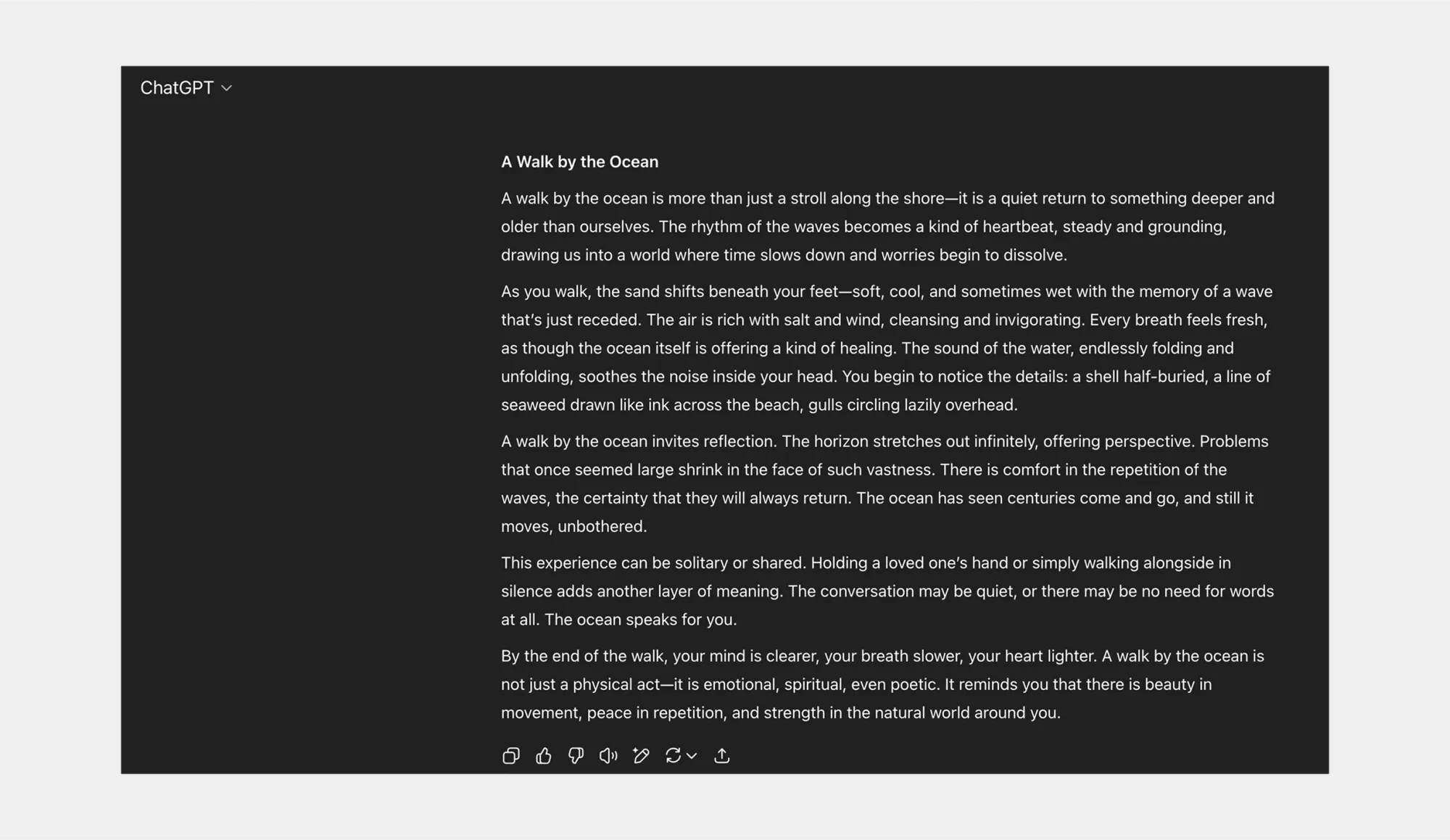
Claude’s essay, meanwhile, adopted a more vivid and evocative style, rich with metaphor and imagery that engaged the senses in a slightly more dramatic way. There was a lyrical intensity in phrases like “nature’s most ancient symphony” and “the ocean’s persistence… a masterclass in both power and patience,” which lent a contemplative grandeur to the piece.
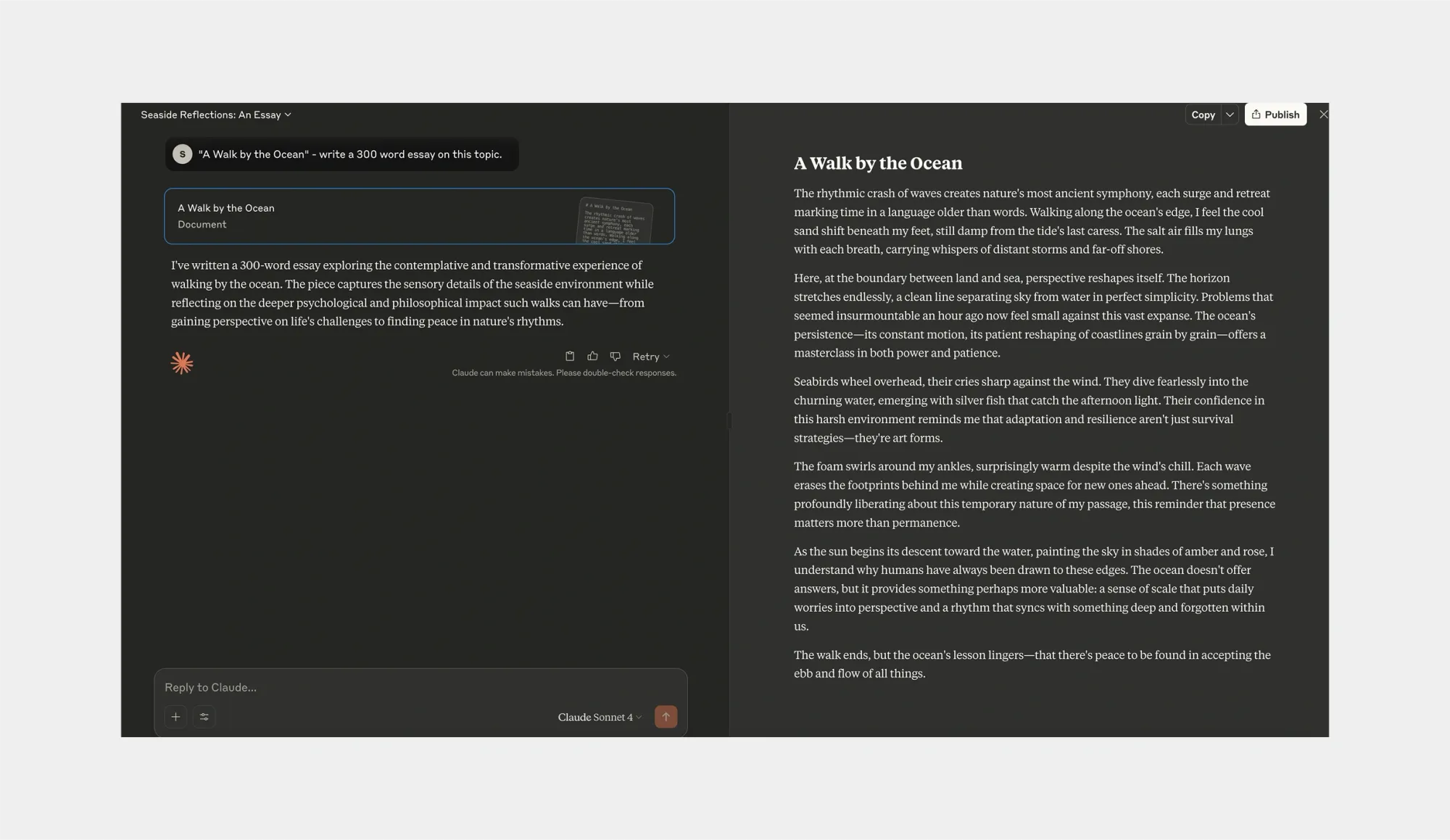
Claude’s language was more elaborate and painterly, with subtle symbolism, such as seabirds embodying resilience, and exploring themes of impermanence and presence. The tone felt a bit more philosophical and immersive, encouraging the reader to dwell on the ocean’s deeper lessons.
Who wins?
Both succeeded in transporting the reader to the ocean’s edge but did so with different flavours:
- ChatGPT with gentle reassurance
- Claude with profound lyrical depth
Depending on the mood or audience, either could resonate beautifully: ChatGPT for a calm, accessible meditation, Claude for a more intense, artistic journey.
Note: Both tools delivered essays very close to the 300-word target: ChatGPT with 288 words and Claude with 292, showing a strong awareness of the length even if not exact.
4. Managing and Analyzing Files
We provided ChatGPT and Claude with a 14-page academic paper analyzing Dylan Thomas’ poetic style to see how they would handle a complex and detailed text.
ChatGPT’s overview was structured as a clear, accessible breakdown of the paper’s main sections: abstract, context, style development, themes, career phases, and conclusion. It used straightforward language and bullet points, making the complex content digestible and easy to follow.
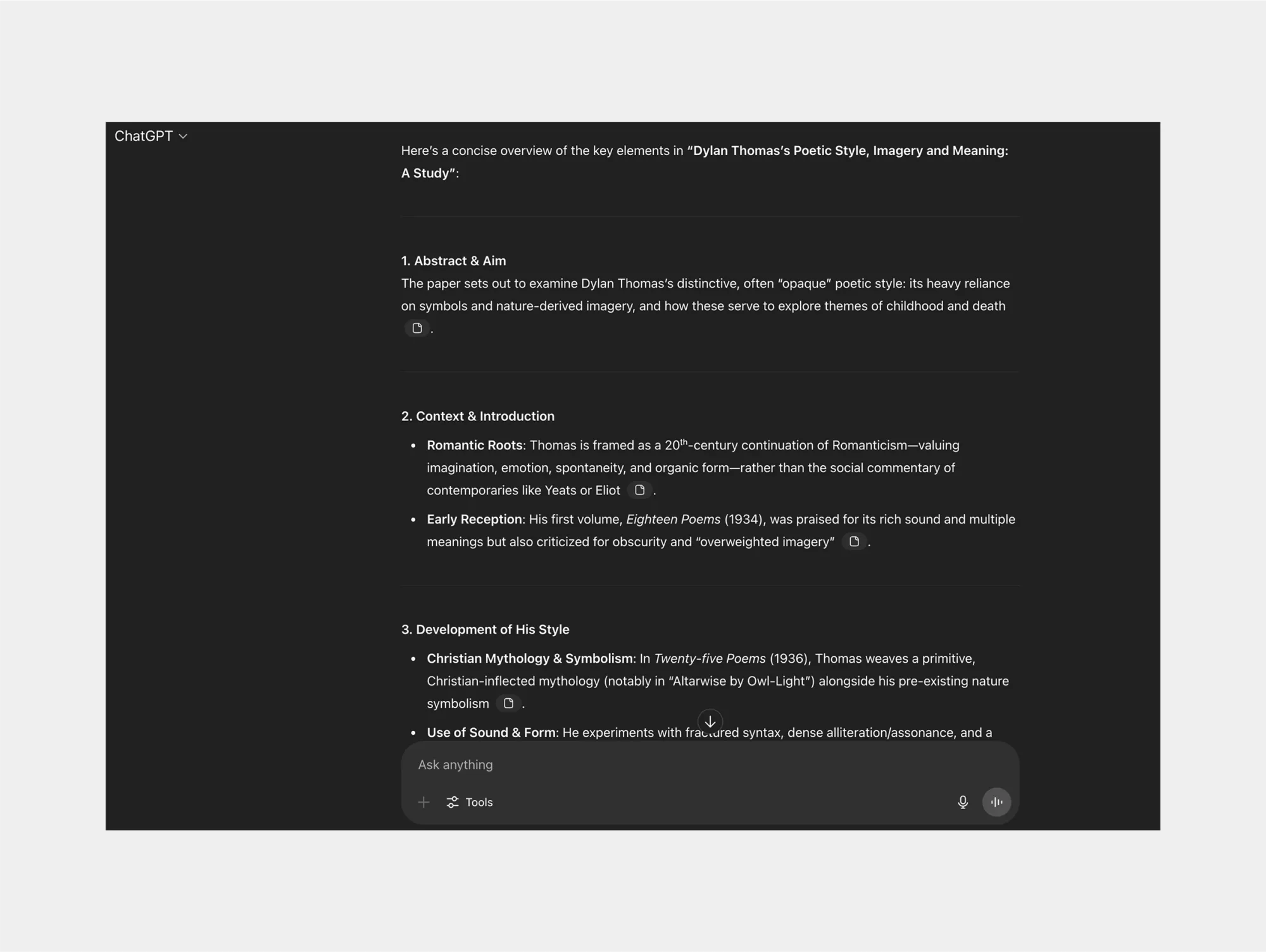
This summary highlighted key themes like Romantic influences, use of nature symbolism, and Thomas’ innovative sound techniques, while also tracing his career development chronologically. ChatGPT’s tone was concise and somewhat formal, aiming to present the information clearly without overwhelming the reader.
Claude’s analysis, while similarly detailed, adopted a more analytical style. It emphasized the paper’s critical arguments, while also focusing deeply on Thomas’ divergence from contemporaries, his Romantic revival, and the complex symbolism rooted in natural cycles and mythology.
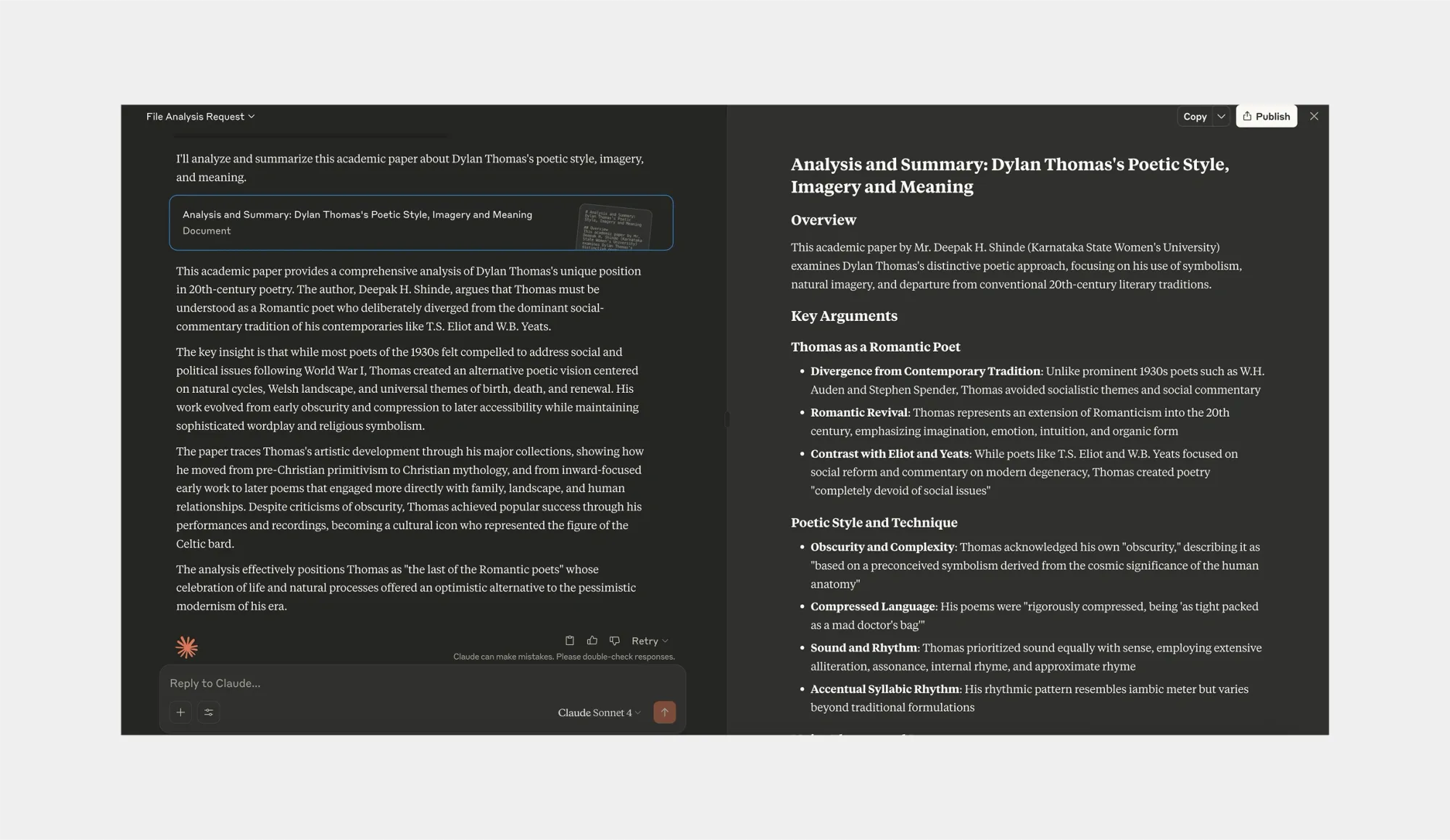
Claude’s summary explored technical innovations and critical reception in more layered detail, integrating quotes and scholarly commentary. The tone felt more academic, with a richer vocabulary and more interpretive insight into Thomas’ place in the 20th-century poetry and his lasting cultural impact.
Who wins?
Overall, ChatGPT excelled at breaking down and organizing dense information into a user-friendly summary, ideal for readers seeking a quick yet comprehensive overview.
Claude, meanwhile, offered a deeper dive that captured the paper’s critical subtleties and intellectual context, appealing more to readers interested in a thoughtful literary analysis.
Both were valuable, but Claude’s rendition felt more immersive and reflective, while ChatGPT’s was more practical.
5. Image Comprehension
To evaluate how effectively ChatGPT and Claude interpret visual information, we presented each with the same textbook-style diagram illustrating renewable energy concepts. The task was straightforward: analyze the image and provide a clear, accurate explanation of its content and significance.
ChatGPT’s response was slightly metaphorical, emphasizing the “atom” analogy throughout. It broke down the diagram into clear sections - what you see, what it means, and key takeaways, making the explanation highly organized and easy to follow.
ChatGPT also highlighted the environmental trade-offs between renewables and non-renewables, tying the explanation to real-world relevance. The metaphor helped ground abstract concepts in a familiar framework, aiding comprehension.
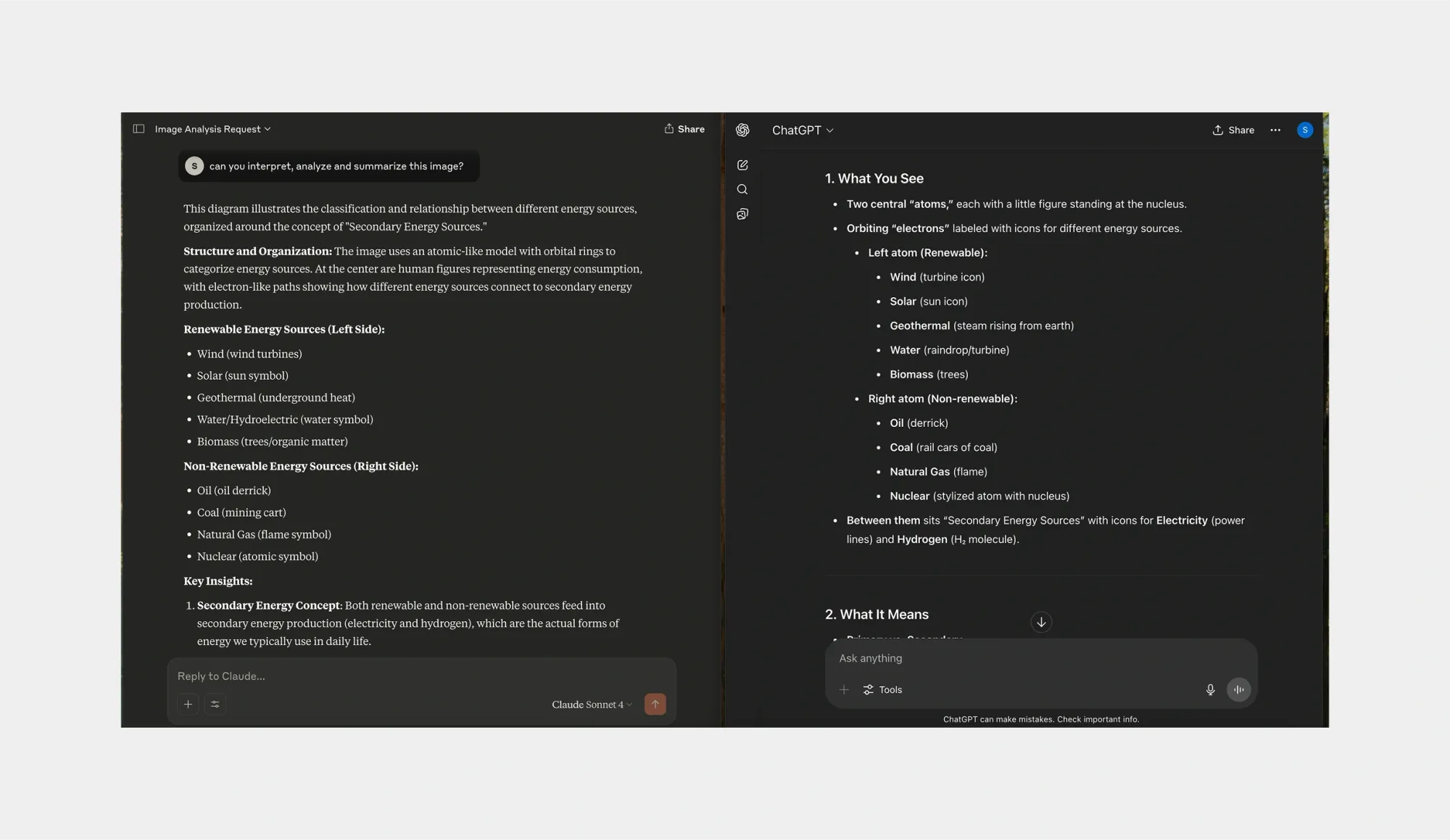
Claude’s explanation was more straightforward and concise, focusing on describing the diagram’s structure and the relationship between energy sources and their transformation into secondary energy forms.
Its style also felt a bit more direct and pragmatic, presenting the diagram as a functional model rather than a conceptual metaphor. It provided clear labels and grouped the sources neatly but used less thematic framing than ChatGPT.
Who wins?
ChatGPT’s answer offered a more detailed, metaphor-rich, and pedagogical approach that contextualized the diagram within sustainability and energy discussions.
Claude provided a succinct, practical summary focusing on the functional relationships depicted.
Depending on the audience, educational or technical, the strengths of each explanation could be more or less effective.
6. Social Media Storytelling
We set out to test how well ChatGPT and Claude could flex their creative muscles across today’s top social media platforms, each with its own tone, audience, and storytelling style. The assignment: promote a new eco-friendly water bottle brand called “Flow.” The product combines sleek, minimalist design with practical benefits. It keeps drinks cold for 24 hours and is made from recycled materials.
We asked both models to create content for TikTok, Instagram, LinkedIn, and YouTube. The goal was to see how well each AI could adapt the same brand message to resonate in four very different digital environments.
ChatGPT focused on fast, engaging, and trend-aware content. Its ideas were platform-native, clearly labeled, and immediately usable: perfect for creators or marketing teams needing quick, compelling content. Each platform (TikTok, YouTube, Instagram, LinkedIn) got five focused concepts, many with storytelling hooks, visual cues, and even suggested emojis. ChatGPT’s tone leaned playful and user-centric, making it especially suited to lifestyle and DTC brands.
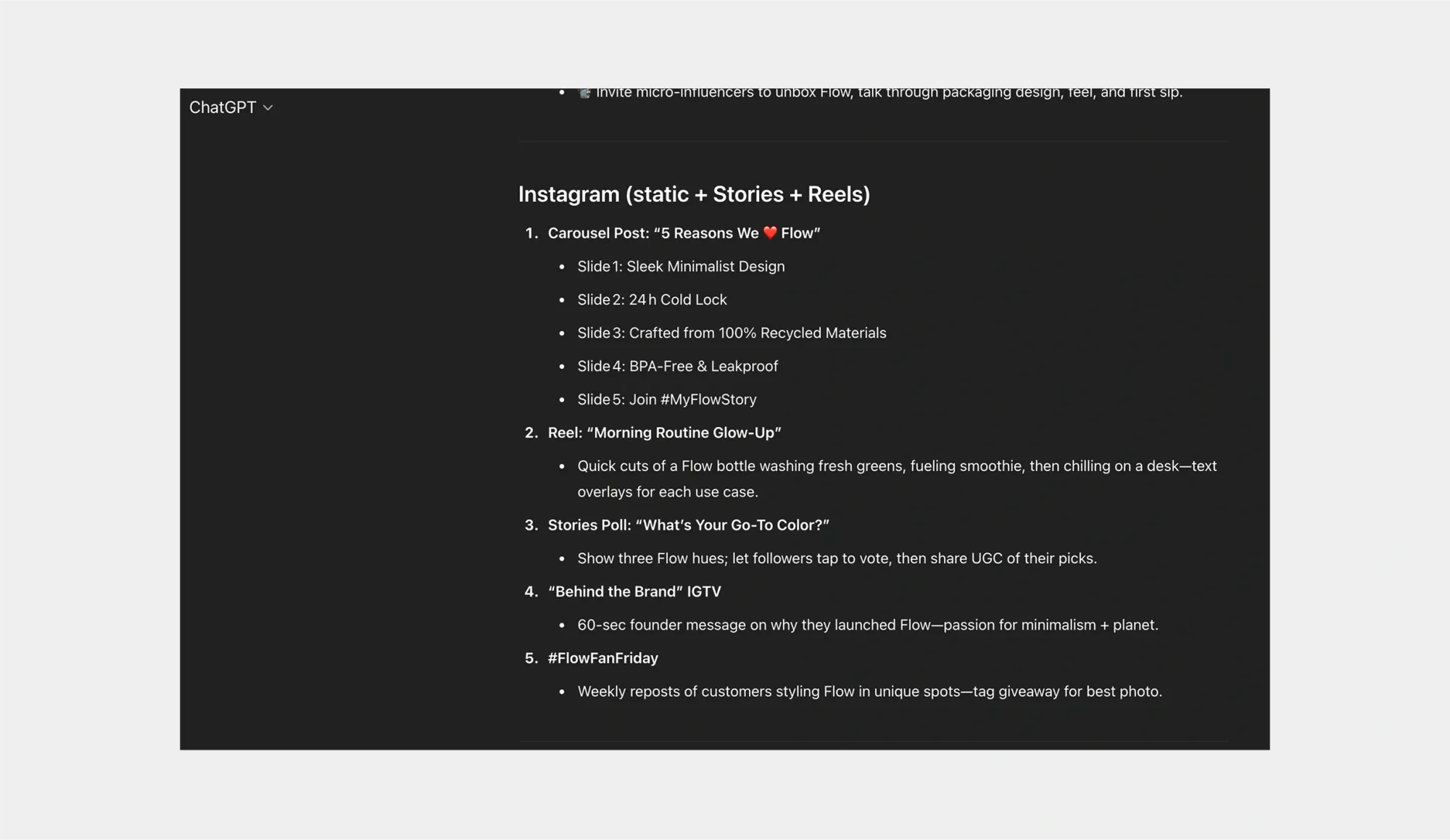
Claude offered a deeper, more exhaustive roadmap. It structured content by format (e.g., reels, stories, feed), included cross-platform campaign ideas, and proposed brand-level content pillars. The tone was more strategic and business-oriented, with ideas suited not only for consumers but also for B2B, investors, and sustainability professionals. It covered educational series, long-form videos, and ROI-based LinkedIn posts in more depth than ChatGPT.
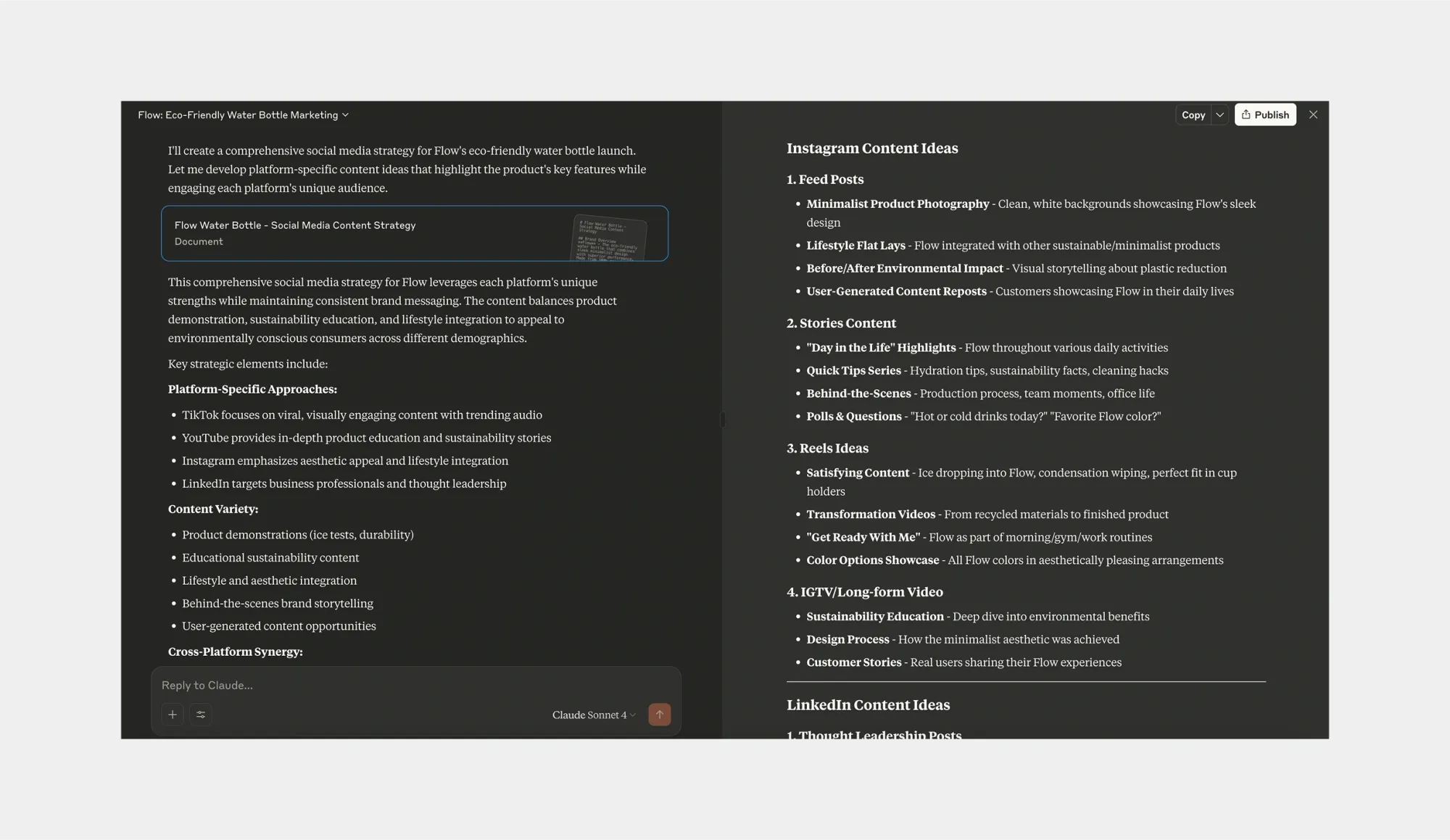
Platform-Specific Execution: Rapid Rundown
Here's how these generative AI tools handled each social media platform.
TikTok
- ChatGPT leaned into fun, rapid, visual trends (e.g., “Design Duels” and “From Trash to Trek”).
- Claude included more evergreen content categories (ice tests, aesthetic routines) but fewer viral-style ideas.
YouTube
- ChatGPT proposed narrative-driven content like “Real-Life Sweat Test” and interviews.
- Claude suggested longer-form educational and comparison videos, including “Flow vs Yeti vs Hydro Flask” - ideal for SEO and buyer research.
- ChatGPT offered Reels, polls, carousels, and brand storytelling.
- Claude took a grid-level view, from minimalistic product shots to transformation videos and lifestyle integration, adding visual planning variety.
- ChatGPT featured startup storytelling and customer impact with more emotional relatability.
- Claude brought a more professional tone, diving into carbon-neutral supply chains, industry trends, and company culture; well-suited for brand partnerships and investors.
Who wins?
Claude, by a slim but meaningful margin.
While both chatbots delivered compelling, well-structured strategies, Claude edged ahead by offering a comprehensive, cross-platform ecosystem that felt like a true brand roadmap, not just content snippets. Its inclusion of campaign arcs, content pillars, and audience segmentation showed an understanding not only of what to post, but why and how it all connects. That level of strategic thinking makes it especially valuable for startups looking to scale sustainably or pitch to stakeholders.
ChatGPT wasn’t far behind, it was sharper, and more native to social media culture, especially for platforms like TikTok and Instagram. Its ideas were ready to shoot, trend-savvy, and designed for instant traction. For teams that need execution-ready ideas, ChatGPT would be the go-to.
But in this round, Claude’s ability to zoom out and build a full brand story across platforms, from eco-conscious consumers to B2B buyers, gave it the edge.
7. Real-Time Search
Both ChatGPT and Claude have specific knowledge cutoffs, which means their training data only includes information up to a certain point. Claude’s cutoff is March 2025, while ChatGPT’s is June 2024. As a result, neither chatbot automatically knows about events or developments occurring after those dates unless their real-time search features are enabled.
When live internet browsing is activated, both bots can access the latest information from across the web, including breaking news, sports scores, and recent discoveries.
To test this, we asked ChatGPT and Claude to provide three major sports news headlines as of June 26, 2025.
ChatGPT’s selection of news focused on high-profile moments in major American sports leagues, including the NBA draft’s number one pick, a near-perfect pitching game in MLB, and a record-breaking scoring milestone in the WNBA. These stories capture key highlights that resonate widely with sports fans in the U.S.
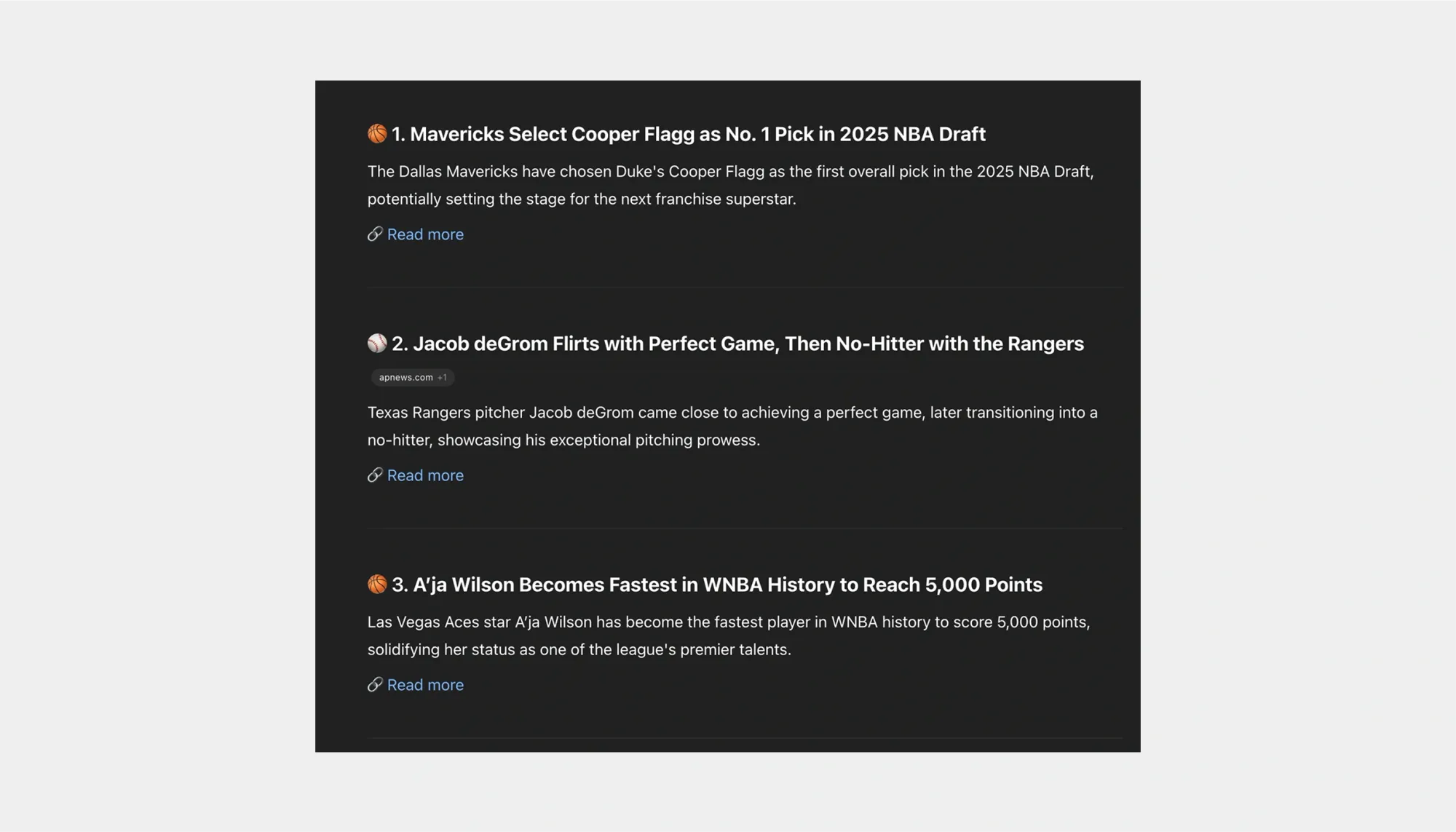
Importantly, ChatGPT provided accurate links directly to the specific news articles, although all came from the same news agency, which might limit source diversity.
Claude offered an internationally diverse set of headlines covering a major NBA trade, a high-profile Premier League transfer, and a notable victory for Ghana’s women’s national football team, reflecting important events across basketball, football, and international women’s sports.
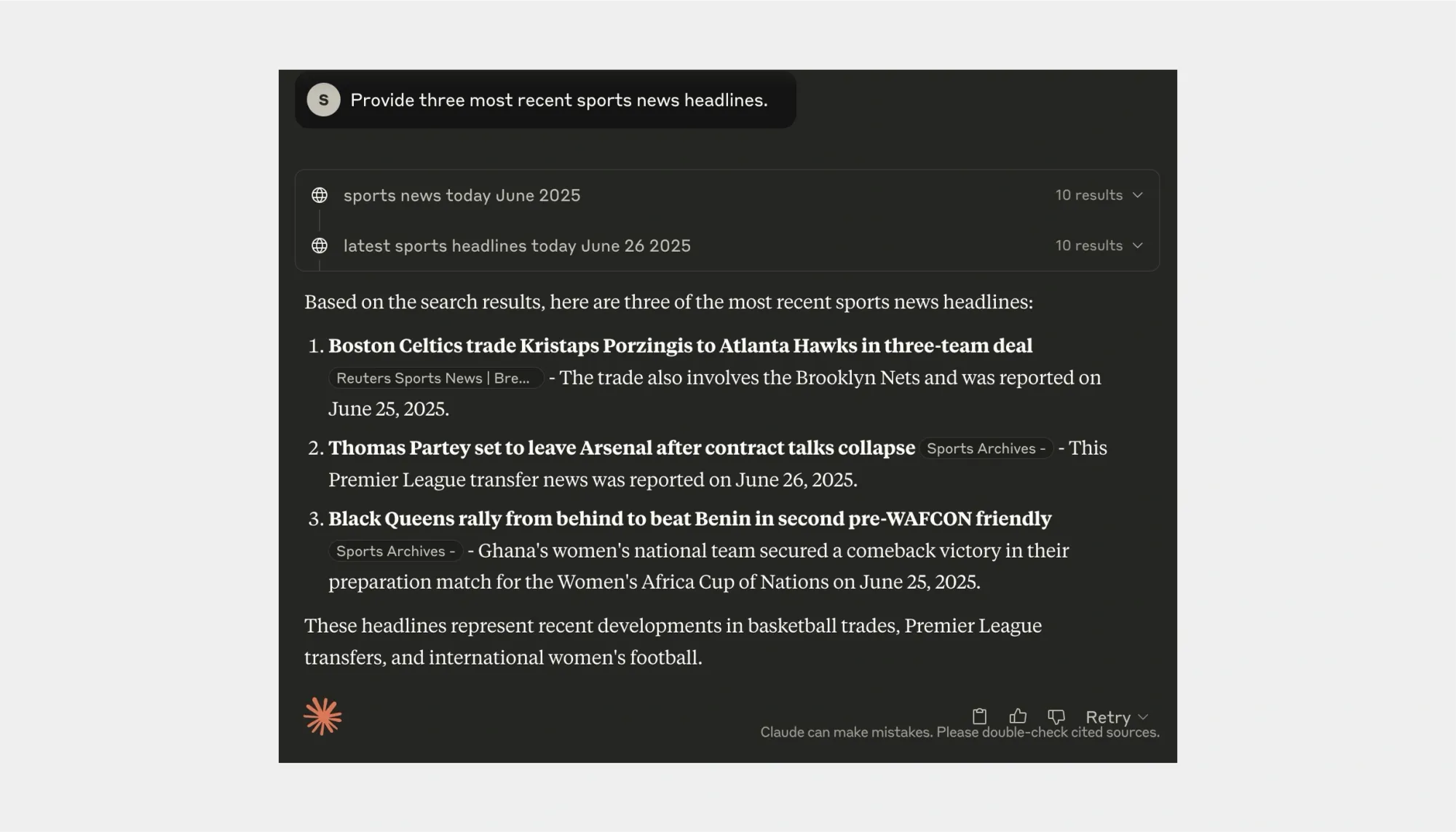
Claude included one direct link to a specific article, but the other two links redirected to a general news page rather than the exact stories, limiting immediate access to details.
Who wins?
Both ChatGPT and Claude demonstrated strong capabilities in delivering timely, relevant sports news with clear and engaging summaries.
ChatGPT emphasized widely notable American sports events, while Claude offered a broader international and multi-sport snapshot, with both showing room for improvement in link accuracy.
In the end, both performed well, but ChatGPT’s direct linking gives it a small advantage for straightforward user convenience.
8. Content Recycling and Reuse
We asked ChatGPT and Claude to transform Podcastle’s blog about the Huberman Lab Podcast into engaging social media content specifically for LinkedIn and Instagram.
ChatGPT’s social media posts struck a professional tone, especially on LinkedIn, where the focus is on data-driven insights, expert credibility, and clear calls to action. The Instagram content was also engaging and visually dynamic, using hashtags and emojis to capture attention while keeping a structured presentation of the podcast’s key themes and impressive reach.
Overall, ChatGPT’s approach felt carefully crafted to appeal to both casual listeners and professionals seeking reliable, research-backed information.
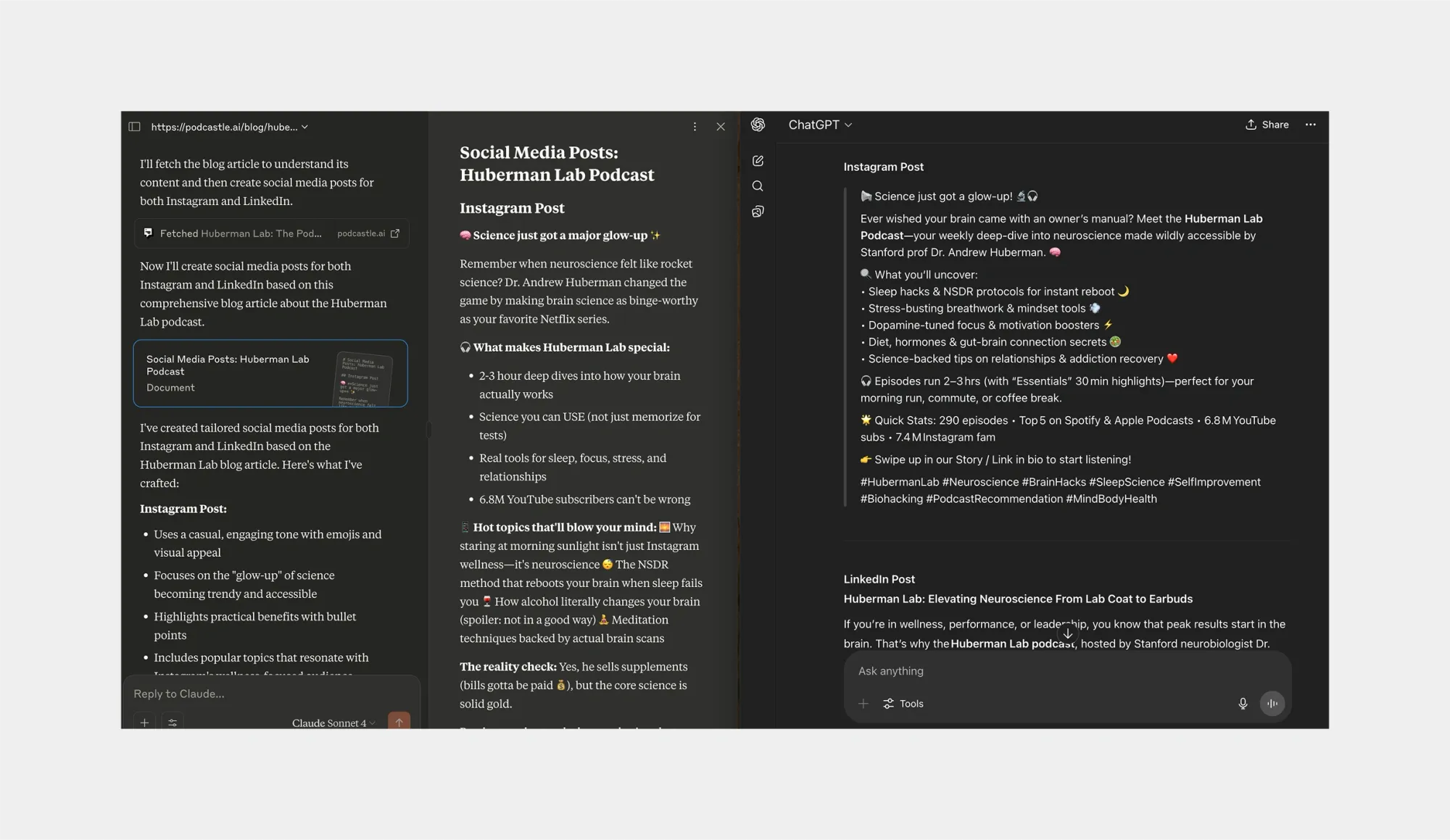
In contrast, Claude’s posts adopted a more conversational and approachable style, using casual language and light humour to make science feel accessible and relatable. The Instagram version invited direct audience engagement with questions and simplified explanations, while the LinkedIn post balanced business relevance with a warm tone that acknowledged some controversy without detracting from the podcast’s value.
Claude’s style encouraged interaction and connection, aiming to create a friendly and inviting atmosphere around the content.
Who wins?
Both ChatGPT and Claude delivered strong, well-crafted posts. The better choice depends on the desired voice and audience.
9. Summarization
To assess their ability to summarize effectively, we tasked both chatbots with condensing O. Henry’s short story After Twenty Years. This narrative, known for its ironic twist and emotional tension, challenged the models to capture key plot points while maintaining the story’s mood and subtlety.
Both ChatGPT and Claude provided clear and concise summaries of O. Henry’s After Twenty Years, mentioning the main plot points and key themes such as loyalty, time, and moral choices. Their versions were quite similar, outlining the pact between the two friends, the meeting after twenty years, the surprising reveal of the undercover officer, and the emotional tension behind the arrest. Each summary conveyed the story’s irony and subtle emotional complexity without overloading on detail, making them accessible and well-structured.
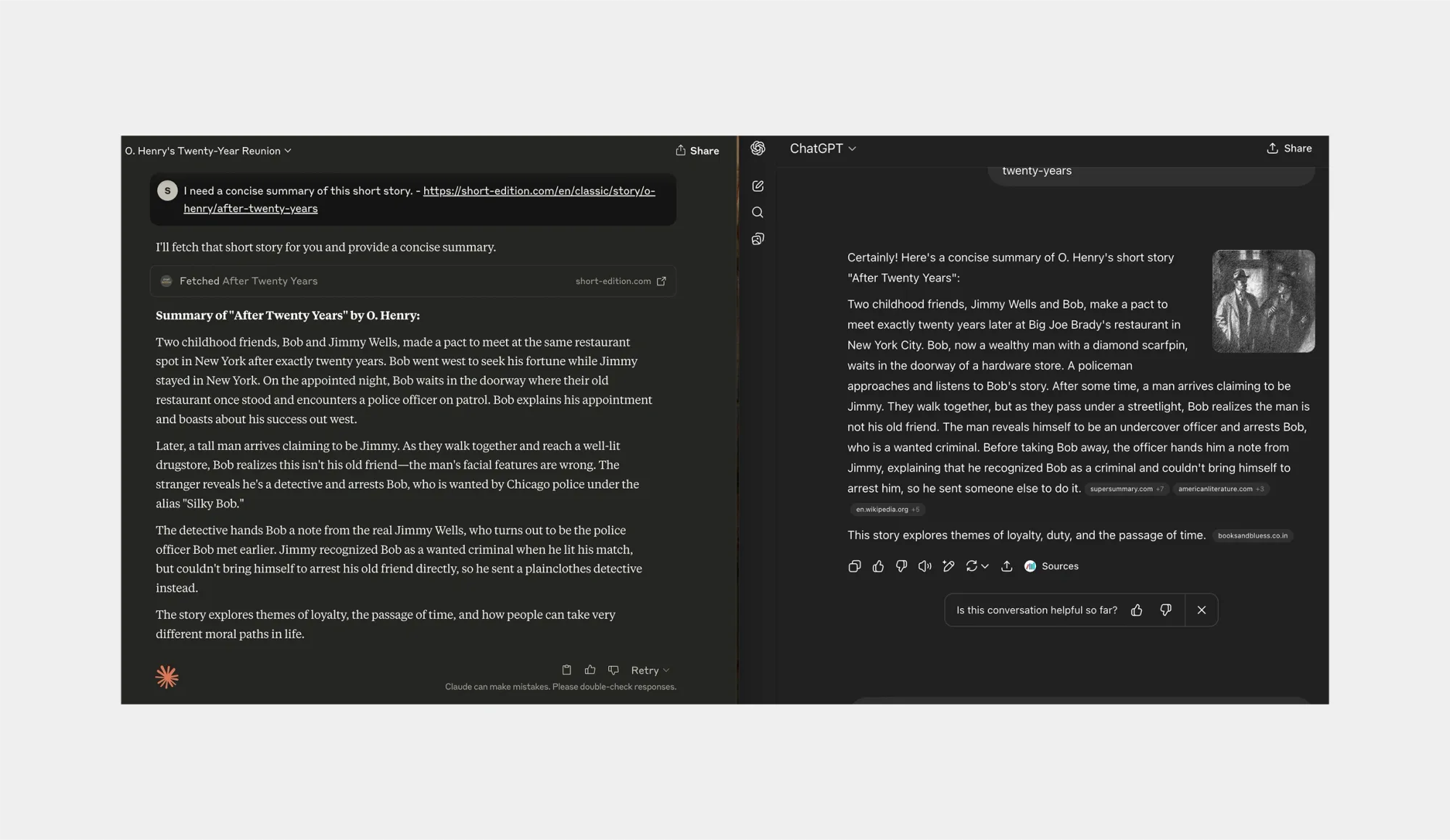
Interestingly, in a previous comparison involving DeepSeek summarizing the same story, ChatGPT had made a factual error about a plot detail, which affected its accuracy. In this case, however, both ChatGPT and Claude performed with no mistakes, delivering accurate retellings.
Who wins?
The results show that ChatGPT and Claude effectively met the task’s requirements. In this case, there’s no clear winner, each performed solidly and fulfilled the assignment as expected.
Which AI Nails the Fundamentals?
1. Creativity
Both ChatGPT and Claude handle creative prompts well, but they tend to express different styles. ChatGPT often favours structured creativity with strong metaphors and hooks, which makes it shine in marketing content and storytelling.
Claude, on the other hand, leans slightly more introspective and poetic, often producing more emotionally nuanced writing. It feels more “writerly,” whereas ChatGPT feels more “editorial.”
Tie: Both deliver compelling creativity, just through different artistic lenses.
2. Structure
ChatGPT generally produces more clearly organized outputs by default, using headings, bullet points, and labeled sections to guide the reader.
Claude can produce structured content too, but sometimes leans toward long, paragraph-heavy formats unless specifically prompted otherwise.
Winner - ChatGPT: Its natural tendency to format responses with clear sections and visual hierarchy makes it easier to scan.
3. Tone Adaptability
Claude often mirrors tone subtly and conversationally, which shines in professional and humanized content.
ChatGPT, however, excels at tailoring tone precisely across a broader spectrum, from playful to corporate to scientific. It’s especially good at adapting your content to the exact tone of different social media platforms, from Instagram and TikTok to LinkedIn.
Winner - ChatGPT: Its tonal precision makes it slightly more versatile across platforms.
4. Accuracy
All large language models, ChatGPT and Claude included, can be inconsistent when it comes to factual precision. While neither bot made any significant errors during our comparison here (aside from Claude’s minor issue with inaccurate links in the sports news test), it’s important to note that hallucinations remain a known limitation across all AIs.
In previous benchmarking, such as our test with DeepSeek, ChatGPT did misstate a key plot point in After Twenty Years, illustrating that no model is immune. That said, in this round of evaluation, both Claude and ChatGPT delivered clean, factually sound results.
Tie: Both models performed reliably in this case, but like all AIs, occasional missteps are possible.
Note: It's always smart to fact-check AI-generated content, especially when dealing with sensitive or high-stakes information.
5. Speed and Efficiency
ChatGPT practices the art of saying more with less: crisp, direct, done. Claude believes in the value of explanation, sometimes taking the scenic route to ensure understanding. One's a text message, the other's a phone call. Both get you there, but the journey feels different.
Winner - ChatGPT: Delivers complete answers with fewer words and less processing time.
6. Security and Data Handling
Both platforms guard user data like protective parents, but with different parenting styles. Claude wraps conversations in automatic encryption both in transit and at rest, with Anthropic employees locked out by default unless you explicitly invite them in through feedback sharing.
ChatGPT takes a more flexible approach - secure for daily use, but on free tiers your conversations might join the training data pool unless you flip the chat history switch off.
Enterprise users get the full fortress treatment with GDPR compliance and admin controls.
Tie: Both prioritise user safety with equally strong but philosophically different approaches.
Claude AI vs ChatGPT: Pros and Cons
As you may have noticed by now, Claude AI and ChatGPT bring impressive capabilities to the table, each with its own set of strengths and challenges. Their interplay of power and subtle limitations highlights how far AI has come, offering tools that can inform, create, and engage with remarkable detail, yet still leave room for improvement.
Ultimately, the best choice depends on what you value most: speed and versatility or clarity and conversational ease. Here is a quick breakdown of the main pros and cons of each chatbot to help you better understand their quirks, superpowers, and occasional hiccups.
ChatGPT Pros
- Exceptional Creativity & Voice Control: ChatGPT excels in creative tasks, such as scripting, branding, metaphors, tone shifts, often delivering copy with strong personality and rhythm.
- Multilingual Support: ChatGPT offers strong, fluent performance across 100+ languages, making it a perfect tool for global users and multilingual content creation.
- Structured Thinking: Provides highly organized outputs with clean bullet points, headings, and logical flow.
- Fast, Responsive Performance: Especially with GPT-4o, response time is extremely fast across both simple and complex tasks.
- Multi-Modal Capabilities: Can analyze images, generate visuals (both images and videos), read files, run Python code, and browse the web (with tools enabled).
- Custom GPTs: Offers tailored AI agents for specific workflows (writing, legal, code review, etc.), helpful for power users.
- Strong Ecosystem: Available on web, mobile, macOS desktop, with features like memory, file uploads, and a consistent user interface.
ChatGPT Cons
- Knowledge Cutoff (Without Tools): Offline model knowledge ends in June 2024, so without search tools enabled, it won’t know post-cutoff events.
- Occasional Over-Explaining: Sometimes over-explains simple answers or repeats phrasing.
- Possible Hallucinations: Like all LLMs, can confidently invent facts, especially with niche or ambiguous queries.
- Limited Access on Free Plan: To use GPT-4o regularly, you’ll need to subscribe to the ChatGPT Plus plan, which costs $20 per month.
Claude AI Pros
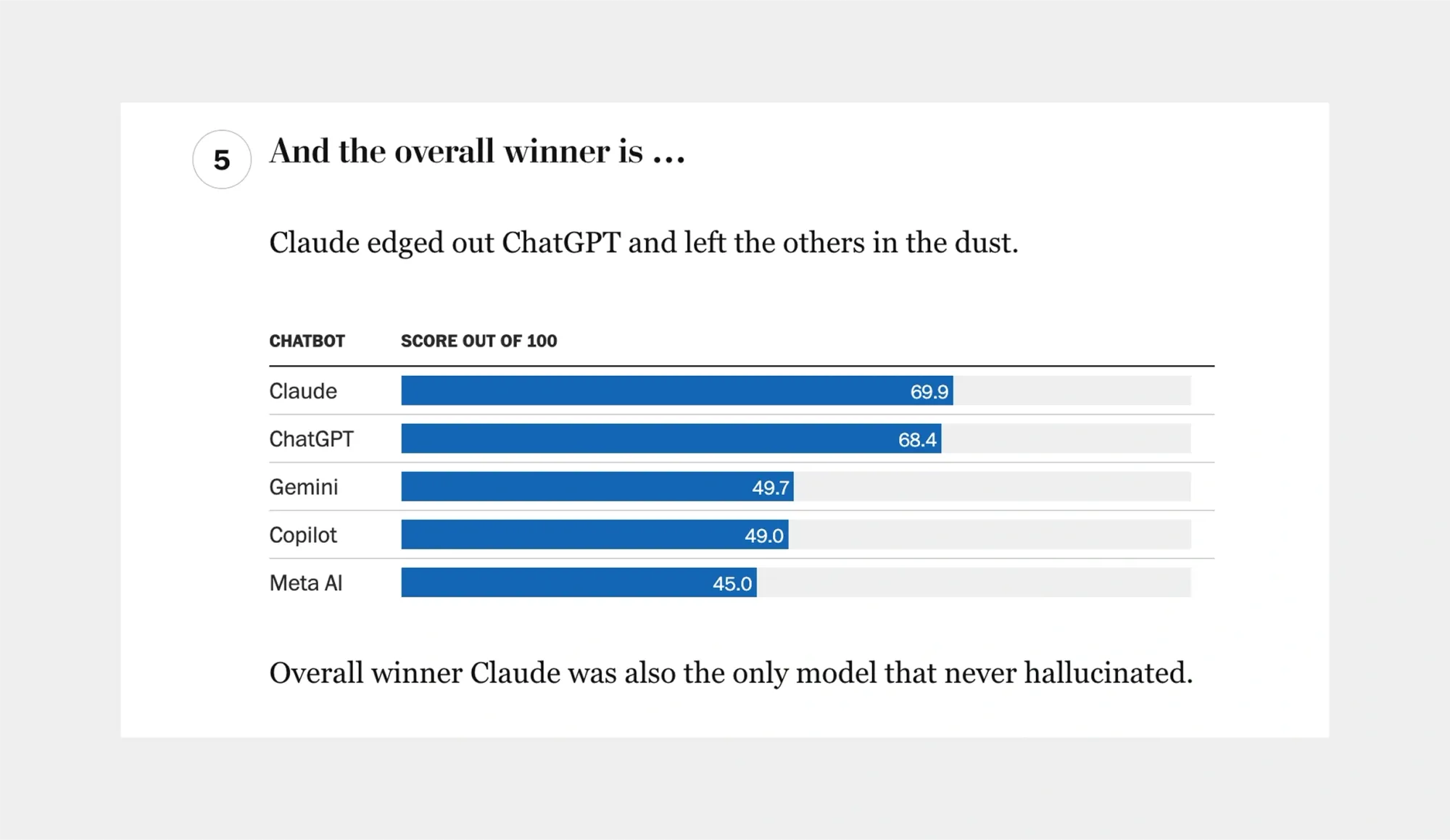
- Naturally Conversational Tone: Claude tends to produce clear, human-like writing that feels organic and relatable, especially in longer pieces.
- Strong Context Window: Claude 3 Opus can handle over 200k tokens (the length of a typical full-length novel), allowing for processing of long documents, transcripts, or conversations.
- Factual Restraint: Often more cautious with uncertain info and less prone to fabricate when compared to other models. In a major review by The Washington Post, Claude was the only model out of five (including ChatGPT) that never hallucinated when answering hard reading comprehension questions.
- Balanced Performance: Handles both analytical and creative tasks well, especially with human-like formatting and tone.
- Multilingual Support: While not as extensive as ChatGPT, Claude still supports over 10 languages.
- Emotionally Intelligent Creativity: Claude often delivers writing with emotional and poetic depth, and a strong sense of voice, making it especially compelling for narrative writing, reflective essays, or human-centered storytelling.
Claude AI Cons
- Slower Than GPT-4o: Generally responds slower, especially in free or lower-priority access modes.
- Limited Multimodal Access: No native image or video generation in public-facing versions.
- Knowledge Cutoff: As of now, Claude’s knowledge stops at March 2025, unless live web tools are integrated.
Who Wins: ChatGPT or Claude?
When it comes down to choosing between ChatGPT and Claude, the better option really depends on you - your workflow, your style, and your goals.
If you’re a fast-paced content creator, marketer, or strategist who values tight structure, tone control, and multi-platform versatility, ChatGPT is likely your ideal creative partner. It’s quick, polished, and highly adaptable, with the added bonus of built-in tools and seamless formatting that make it feel ready for production straight out of the box.
On the other hand, if you’re a writer, researcher, or storyteller who values nuance, emotional depth, and a more human rhythm to your writing, Claude might be the one you reach for first. It’s introspective, articulate, and often better at capturing subtlety, making it a great fit for long-form storytelling, thoughtful analysis, or anything where voice and empathy are key.
For podcasters, we have two different options:
- If you're a podcaster focused on narrative depth, emotional arcs, and character-driven stories (documentary-style episodes, interviews, or thematic storytelling), Claude may be your better collaborator. It excels at natural, human-sounding dialogue and weaving tone-rich scripts with an organic flow.
- If you're producing high-volume content, structured episodes, or multi-segment shows with intros, transitions, and pacing cues (like educational pods, industry roundups, or interview compilations), ChatGPT will likely serve you better. It’s fast, format-aware, and tends to output production-ready scripts with strong clarity and modular structure.
That said, take these conclusions with a grain of salt - they are case-specific, not absolute. These results reflect a specific set of tasks and testing scenarios; in another context, the performance dynamics could shift completely. Both models are impressively versatile generalists, and either can excel across a wide range of use cases when prompted correctly.
So take this guide as a helpful compass, not a final answer. Your best bet? Try both. See which one thinks the way you think, or fills in where you don’t.
